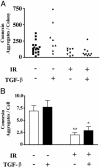Ionizing radiation induces heritable disruption of epithelial cell interactions
- PMID: 12960393
- PMCID: PMC196872
- DOI: 10.1073/pnas.1832185100
Ionizing radiation induces heritable disruption of epithelial cell interactions
Abstract
Ionizing radiation (IR) is a known human breast carcinogen. Although the mutagenic capacity of IR is widely acknowledged as the basis for its action as a carcinogen, we and others have shown that IR can also induce growth factors and extracellular matrix remodeling. As a consequence, we have proposed that an additional factor contributing to IR carcinogenesis is the potential disruption of critical constraints that are imposed by normal cell interactions. To test this hypothesis, we asked whether IR affected the ability of nonmalignant human mammary epithelial cells (HMEC) to undergo tissue-specific morphogenesis in culture by using confocal microscopy and imaging bioinformatics. We found that irradiated single HMEC gave rise to colonies exhibiting decreased localization of E-cadherin, beta-catenin, and connexin-43, proteins necessary for the establishment of polarity and communication. Severely compromised acinar organization was manifested by the majority of irradiated HMEC progeny as quantified by image analysis. Disrupted cell-cell communication, aberrant cell-extracellular matrix interactions, and loss of tissue-specific architecture observed in the daughters of irradiated HMEC are characteristic of neoplastic progression. These data point to a heritable, nonmutational mechanism whereby IR compromises cell polarity and multicellular organization.
Figures




Similar articles
-
Ionizing radiation predisposes nonmalignant human mammary epithelial cells to undergo transforming growth factor beta induced epithelial to mesenchymal transition.Cancer Res. 2007 Sep 15;67(18):8662-70. doi: 10.1158/0008-5472.CAN-07-1294. Cancer Res. 2007. PMID: 17875706
-
Regulation of endothelial barrier function and growth by VE-cadherin, plakoglobin, and beta-catenin.Am J Physiol Cell Physiol. 2002 Sep;283(3):C811-21. doi: 10.1152/ajpcell.00417.2001. Am J Physiol Cell Physiol. 2002. PMID: 12176738
-
Autoregulation of E-cadherin expression by cadherin-cadherin interactions: the roles of beta-catenin signaling, Slug, and MAPK.J Cell Biol. 2003 Nov 24;163(4):847-57. doi: 10.1083/jcb.200308162. Epub 2003 Nov 17. J Cell Biol. 2003. PMID: 14623871 Free PMC article.
-
Cadherin-catenin complex: protein interactions and their implications for cadherin function.J Cell Biochem. 1996 Jun 15;61(4):514-23. doi: 10.1002/(SICI)1097-4644(19960616)61:4%3C514::AID-JCB4%3E3.0.CO;2-R. J Cell Biochem. 1996. PMID: 8806074 Review.
-
Dynamic control of cell-cell adhesion for multicellular organization.C R Acad Sci III. 1993 Sep;316(9):813-21. C R Acad Sci III. 1993. PMID: 8076212 Review. English, French.
Cited by
-
Nanoparticle-Mediated Radiotherapy Remodels the Tumor Microenvironment to Enhance Antitumor Efficacy.Adv Mater. 2023 May;35(21):e2206370. doi: 10.1002/adma.202206370. Epub 2023 Apr 2. Adv Mater. 2023. PMID: 36524978 Free PMC article. Review.
-
Presence of Stromal Cells Enhances Epithelial-to-Mesenchymal Transition (EMT) Induction in Lung Bronchial Epithelium after Protracted Exposure to Oxidative Stress of Gamma Radiation.Oxid Med Cell Longev. 2019 Sep 8;2019:4120379. doi: 10.1155/2019/4120379. eCollection 2019. Oxid Med Cell Longev. 2019. PMID: 31583039 Free PMC article.
-
Beta-catenin is a mediator of the response of fibroblasts to irradiation.Am J Pathol. 2009 Jan;174(1):248-55. doi: 10.2353/ajpath.2009.080576. Epub 2008 Nov 26. Am J Pathol. 2009. PMID: 19036807 Free PMC article.
-
HZE Radiation Non-Targeted Effects on the Microenvironment That Mediate Mammary Carcinogenesis.Front Oncol. 2016 Mar 11;6:57. doi: 10.3389/fonc.2016.00057. eCollection 2016. Front Oncol. 2016. PMID: 27014632 Free PMC article. Review.
-
Breast cancer by proxy: can the microenvironment be both the cause and consequence?Trends Mol Med. 2009 Jan;15(1):5-13. doi: 10.1016/j.molmed.2008.11.001. Epub 2008 Dec 16. Trends Mol Med. 2009. PMID: 19091631 Free PMC article.
References
-
- Mattsson, A., Ruden, B.-I., Wilking, N. & Rutqvist, L. E. (1993) J. Natl. Cancer Inst. 85, 1679–1685. - PubMed
-
- Mauch, P. (1995) Int. J. Radiat. Oncol. Biol. Phys. 33, 959–960. - PubMed
-
- Davis, F. G., Boice, J. D., Hrubec, Z. & Monson, R. R. (1989) Cancer Res. 49, 6130–6136. - PubMed
-
- Tokunaga, M., Land, C. E., Yamamoto, T., Asano, M., Tokuoka, S., Ezaki, H. & Nishimori, I. (1987) Radiat. Res. 112, 243–272. - PubMed
Publication types
MeSH terms
Substances
LinkOut - more resources
Full Text Sources
Other Literature Sources
Research Materials
Miscellaneous

